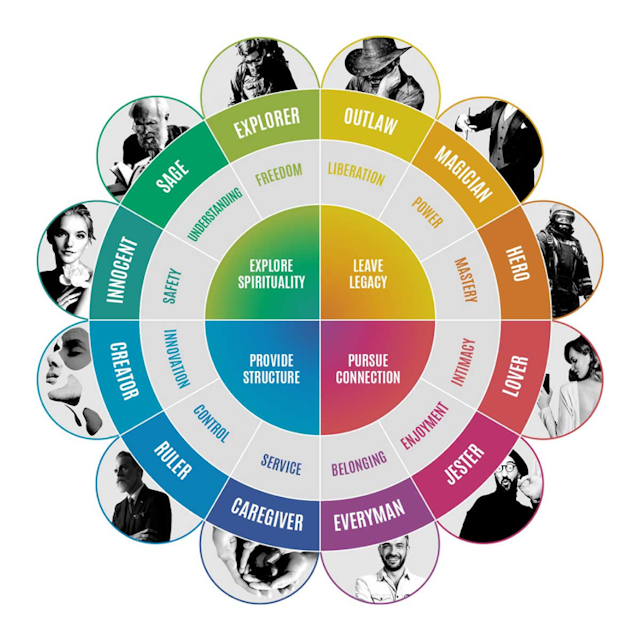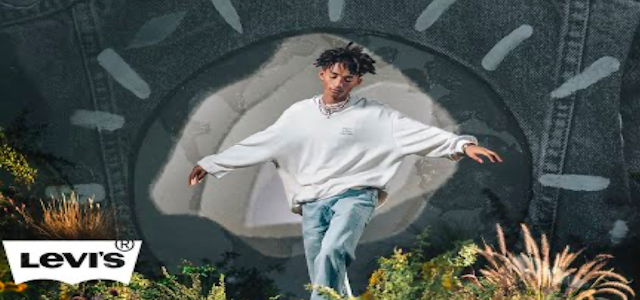Four brand archetypes for creating powerful climate narratives
Carl Jung's archetypes and their infographic-friendly framework are commonplace in advertisers’ tool kits, perfect for segmenting audiences and crafting brand personas. Media Bounty strategist Ellie Malpas takes a look at the four main archetypes and how they can be useful in reframing narratives.

Media Bounty apply Carl Jung's four archetypes to advertising.
While some people may dismiss Carl Jung's archetypes as ‘marketing BS’, their focus on the core human drives (order, spirituality, connection and legacy) make them interesting from a climate change perspective.
As we know from studying climate misinformation, the most successful narratives speak to people’s identity and values. These stories fuel culture wars and form identity-based politics in climate delayers and deniers by latching onto what they care about.
We can use these powerful framing tactics to own back the conversation and inspire positive change. Climate-related comms usually lack the aspirational messaging we see in brand adverts. When we buy a brand, we are usually buying a little bit of an identity for ourselves, or an extension of an idea of who we are. Instead, green advertising often relies on factual claims, ‘natural’ colors, and intangible realities.
Jung's 4 human drivers of behavior can help us avoid this trap and craft more powerful narratives for the climate fight, connecting to people's values and identities.

The core drivers of human behavior (middle) are expressed by the 12 archetypes surrounding them.
1) Innovator (core drive: structure)
People who are driven by structure seek to provide order to the world around them. For the innovator archetype, they realize this through big ideas and creative problem solving. They will get behind narratives that allude to progression in the way society works or introduce exciting new concepts.
Creating powerful climate messaging: Frame the climate fight as a technological revolution and an opportunity to be ahead of the curve. For individuals we can frame buying sustainable products as forward-thinking, trendsetting behavior. When looking at broader society and talking to key decision makers, green solutions offer a political opportunity, and allow an energy revolution.
What to avoid: Overly spiritual language and cliche narratives around a connection to nature and saving our grandchildren is unlikely to capture an innovator's soul. While they are creative, they are more driven by proactive solutions over metaphors and anything that may lump them into the Hareem-pant-wearing-hippie stereotype.
The Future Is Electric nailed it for innovators.
2) Explorer (core drive: spirituality)
The explorer is hedonistic at heart and driven by a need to find spiritual understanding of the world and people in it. This means traveling if fortunate, or a desire to explore new experiences. This personality type is captured by myths, stories and secrets. They are the life and soul of the party, and might know their rising sun and moon signs off by heart.
Creating powerful climate narratives: What may deter the innovator may excite the explorer. Nature and poetic amplifications of people-focused stories from around the globe are likely to resonate. They are also more likely to be enticed by metaphors such as duties to mother nature. A positive, galvanizing tone can capture their pleasure-seeking inhibitions.
What to avoid: Jargon, facts, and too much information may turn our explorers off. They’re less likely to respond to time limits and doom and gloom messages. Their hedonism means that we are more likely to capture their hearts by speaking to their needs and desires.

Green & Black's worked well for explorers.
3) Everyman (core drive: connection)
People driven by connection are motivated by relationships and human connection. They are empathetic and are fascinated by people and what makes them tick. The need to belong is core to who they are. They don’t like to stand out, but forge connections easily between different groups of people where their lack of judgement is apparent.
Creating powerful climate narratives: The injustice of climate change is likely to anger this group to which equality is essential. So, highlighting the humanitarian nature of the fight by amplifying stories from the global South is likely to be powerful. They are more likely to be enticed by the ‘granddaughter’ trope, as this speaks to their family-orientated nature. Focus on human repercussions.
What to avoid: The largely white, middle-class of the climate movement may alienate the everyman. Empathizing with the hardships of life, such as poverty, racism and ableism, worries related to the climate may seem a privilege. While there is no quick fix for this, diversity and inclusion is a starting point.

Most Shocking Second a Day Video hits the nail on the head for everymen.
5) Rebel (core drive: legacy)
Leaving a mark on the world is the aspiration of a personality type driven by legacy. For the rebel, this isn’t done by following rules. Rebels may be anti-establishment and mistrust governing bodies. They may fall trap to conspiracy theories and misinformation.
Creating powerful climate narratives: Framing climate activism as anti-establishment is likely to excite the rebel who might grasp the opportunity to compare the climate fight to previous fights against injustice. Highlighting the role of big corporations and the government can galvani`e rebels, who may find solace in climate actions that oppose capitalism.
What to avoid: Corporate messages are likely to cause skepticism, as well as signs of cooperation with the rich and powerful. Talking in layman's terms will be effective. They are less likely to be engaged by messages focused on harmony. 'Toxic positivity' is often met with cynicism and doubt.

Levi's® nailed it for rebels.
Next time you’re selling in sustainability, refrain from the temptation to turn everything green or shove in a ukulele. Instead, look to Mr. Jung.
Content by The Drum Network member:

Media Bounty
We’re Media Bounty. And we’re working to become the UK’s leading ethical independent creative agency by 2026.
Our team delivers award-winning strategy,...

